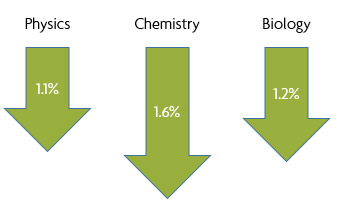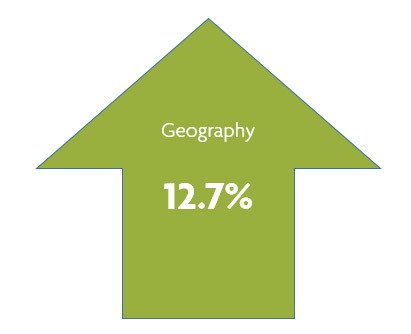August each year brings exam results for thousands of A-Level and GCSE students around the country. Our congratulations go out to all of those who have received their results, and with UCAS reporting record numbers of university places being accepted (since the cap on student numbers has been removed), including across the sciences, we hope that these successes will translate into thriving environmental science courses across the country. However, as we now pause to take stock, various commentators are reporting a mixed picture for STEM nationally.
Declining numbers sitting core science A-Levels
This year has seen fewer numbers of students sitting exams for each of the three core sciences.
The number of students sitting the Physics A-Level has decreased by 1.1 per cent, Chemistry by 1.6 per cent, and Biology by 1.2 per cent (data from JCQCIC, 2015). Maths however, has seen an increase in student numbers of 4.4 per cent. These figures should be considered in the context that the total number of A-Levels taken has risen by two per cent compared to 2014 (from 833,807 to 850,749), despite the fact that there has been a 1.1 per cent fall in the size of the 18 year old cohort in the same year.

Data: JCQCIC, 2015
This small fall in numbers taking core science courses is in itself not overly alarming, but care must be taken that this does not develop into a continued downward trajectory in the coming years if the Government is to deliver on its aim to make the UK the best place in the world to do science.
It is also somewhat disappointing not to see more significant progress towards gender parity in Biology (studied by many more female students), Physics and Maths (where although some improvement can be seen, these subjects are still dominated by male students).
What about environmental science?
Currently, students are unable to sit an A-Level in Environmental Science, although the Government is currently consulting on the syllabus for a new course to be brought in in 2017. However, although environmental science in Higher Education is of course built largely on a core science foundation, there is good news in that Geography (which is also a major feed-in subject for the sector) has seen a 12.7% increase in student numbers in 2015.

This represents a positive trend for environmental disciplines (although the development of fundamental scientific skills, such as an understanding of experimental design and methodology and statistical analysis, remain vital). It is hoped that this surge in interest in Geography can be translated in 2017 into students taking the new Environmental Science qualification.
The development of a dedicated Environmental Science A-Level is an exciting development for the discipline, which is increasingly recognised as an essential companion to its older, core cousins Biology, Physics and Chemistry, and one which is well placed to promote multi-disciplinary collaborations. Society faces ever-growing environmental challenges, and we need to be producing graduates with the skills and knowledge to meet them. It is now more important than ever that we develop an understanding of the complexities of socio-environmental systems and the skills to interrogate data to inform decision-making in our young scientists. This training should begin at school, and although many science teachers do great work developing these skills in their students, the decision to introduce a dedicated A-Level represents an institutional recognition of the importance of our discipline to the future of the UK.
We look forward to working with the Government and regulator, Ofqual, to make these aspirations a reality. The IES, with the Committee of Heads of Environmental Sciences, is currently preparing a response to the draft subject content document released by the Department for Education. If you would like to give any input to this response, please get in touch.





